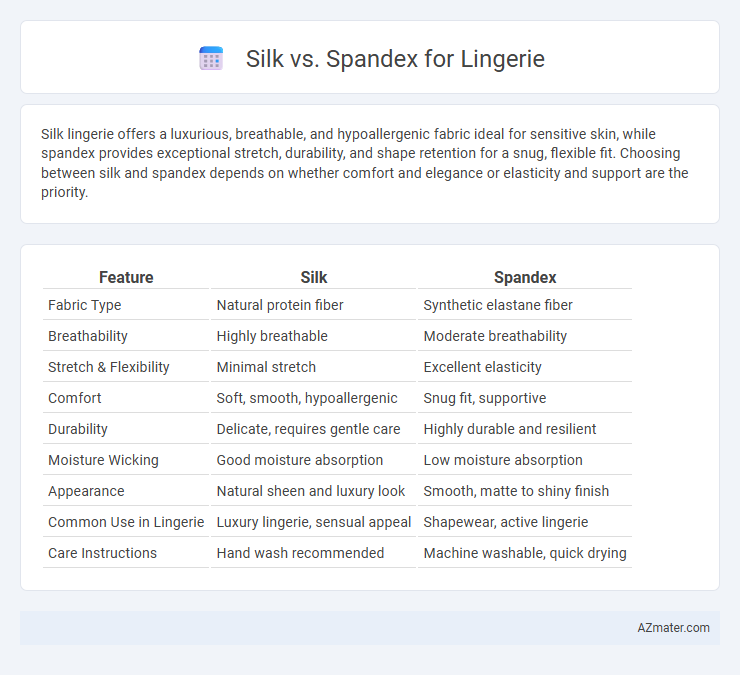Silk lingerie offers a luxurious, breathable, and hypoallergenic fabric ideal for sensitive skin, while spandex provides exceptional stretch, durability, and shape retention for a snug, flexible fit. Choosing between silk and spandex depends on whether comfort and elegance or elasticity and support are the priority.
Table of Comparison
| Feature | Silk | Spandex |
|---|---|---|
| Fabric Type | Natural protein fiber | Synthetic elastane fiber |
| Breathability | Highly breathable | Moderate breathability |
| Stretch & Flexibility | Minimal stretch | Excellent elasticity |
| Comfort | Soft, smooth, hypoallergenic | Snug fit, supportive |
| Durability | Delicate, requires gentle care | Highly durable and resilient |
| Moisture Wicking | Good moisture absorption | Low moisture absorption |
| Appearance | Natural sheen and luxury look | Smooth, matte to shiny finish |
| Common Use in Lingerie | Luxury lingerie, sensual appeal | Shapewear, active lingerie |
| Care Instructions | Hand wash recommended | Machine washable, quick drying |
Introduction to Silk and Spandex in Lingerie
Silk and spandex are two popular fabrics used in lingerie, each offering distinct benefits for comfort and style. Silk, a natural protein fiber, is prized for its smooth texture, breathability, and luxurious feel against the skin, making it ideal for high-end, delicate lingerie. Spandex, a synthetic material known for its exceptional elasticity, provides stretch and support, enhancing fit and flexibility in form-fitting lingerie designs.
Fabric Composition: Natural vs Synthetic
Silk lingerie features natural protein fibers derived from silkworm cocoons, offering breathability and a smooth, luxurious feel ideal for sensitive skin. Spandex lingerie is composed of synthetic polyurethane fibers known for exceptional elasticity and durability, providing superior stretch and shape retention. Choosing between silk and spandex depends on desired comfort, breathability, and fabric performance in lingerie applications.
Comfort and Breathability Comparison
Silk provides superior breathability and natural moisture-wicking properties, making it highly comfortable for lingerie by keeping skin cool and dry. Spandex, while offering excellent stretch and shape retention, lacks the same breathability, often trapping heat and moisture against the skin. For long-term comfort, silk's smooth, hypoallergenic fibers ensure a gentle feel, whereas spandex's synthetic nature may cause irritation in sensitive areas.
Fit and Stretch: Draping on the Body
Silk offers a luxurious, smooth drape that contours naturally to the body, providing an elegant and breathable fit ideal for intimate apparel. Spandex enhances lingerie with superior stretch and elasticity, ensuring a snug, flexible fit that moves effortlessly with the wearer. Combining silk with spandex blends results in lingerie that balances silky softness with adaptive stretch, optimizing comfort and fit through body movement.
Sensation: Touch and Feel Experience
Silk lingerie provides a naturally smooth, breathable, and luxurious sensation against the skin, offering a soft, cool touch that enhances comfort and elegance. Spandex lingerie delivers a stretchy, snug fit that contours the body, providing support and flexibility with a slightly warmer feel due to its synthetic fibers. The choice depends on whether you prioritize the silky softness and natural breathability of silk or the elastic, form-fitting sensation that spandex offers.
Durability and Care Requirements
Silk lingerie offers luxury and softness but demands delicate care, requiring hand washing and careful storage to maintain its durability. Spandex, known for its excellent elasticity and resilience, withstands frequent washing and stretching without losing shape, making it highly durable for everyday wear. Choosing between the two depends on balancing silk's natural elegance with spandex's low-maintenance durability in lingerie.
Aesthetic Appeal and Color Retention
Silk lingerie exudes a natural, luxurious sheen and offers rich, vibrant colors that remain luminous over time due to its protein fibers' excellent dye absorption. Spandex lingerie provides a smooth, sleek appearance with consistent color retention, benefiting from its synthetic composition that resists fading even after multiple washes. The choice between silk and spandex hinges on whether a soft, elegant drape with radiant hues or a form-fitting, color-stable garment is preferred for lingerie aesthetics.
Allergenicity and Skin Sensitivity
Silk is a natural protein fiber known for its hypoallergenic properties, making it ideal for individuals with sensitive skin or allergies. Spandex, a synthetic fiber, may cause irritation or allergic reactions in some people due to its chemical composition and tight fit. Choosing silk lingerie can reduce the risk of skin sensitivity and allergenicity, providing a softer, breathable alternative compared to spandex.
Pricing and Accessibility
Silk lingerie typically commands higher prices due to the cost of natural fibers and labor-intensive production processes, making it a luxury item often found in specialty boutiques or high-end stores. Spandex lingerie offers greater affordability and widespread accessibility, as synthetic materials and mass production reduce costs, enabling availability in mainstream retail outlets and online platforms. Consumers seeking budget-friendly options or frequent replacements often prefer spandex, while those desiring premium quality and natural fabric choose silk despite its higher price point.
Choosing the Right Fabric for Your Needs
Silk offers a luxurious, breathable feel ideal for sensitive skin and elegant lingerie designs, while spandex provides superior stretch and durability, ensuring a snug fit and long-lasting wear. Choosing silk suits those prioritizing natural fibers and comfort, whereas spandex is perfect for active use and maintaining shape throughout the day. Balancing softness, elasticity, and care requirements helps determine the best fabric for your lingerie needs.

Infographic: Silk vs Spandex for Lingerie
 azmater.com
azmater.com